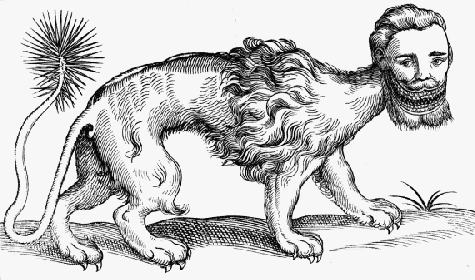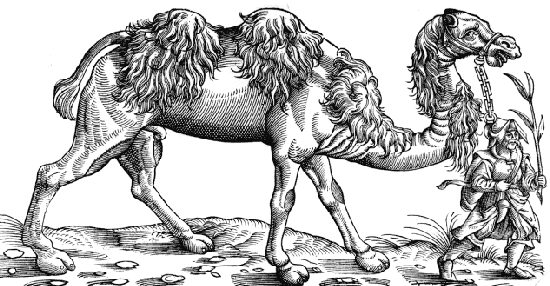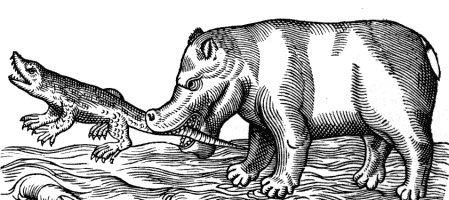Topsell's Beasts
Today, a zoology book. The University of Houston's College of Engineering presents this series about the machines that make our civilization run, and the people whose ingenuity created them.
1607 was the year Shakespeare finished Macbeth, Galileo showed that the path of a projectile is parabolic, and a committee of fifty-four translators was halfway through its task of writing the King James Bible. The alchemical convolutions of the old world were giving way to new clarity and objectivity. 1607 was also the year that a cleric named Edward Topsell published a remarkable 1100-page treatise on zoology. In it he shows us a world that had not quite been overturned by the new scientific method.
Topsell's title begins: The HISTORY of Four-footed Beasts and Serpents Describing at Large Their True and Lively Figure, their Several names, Conditions, Kinds, Virtues ..., and it keeps on going. Here is all you'd ever dare to know about any beast. The illustrations are marvelous, and I'll let the text speak for itself.
Quoting a Roman authority, Topsell says that "Dogs have reason, and use logik in their hunting." But he's compelled to add that "It is the nature of a Dog, when he maketh water, to hold up his leg ..." We're told that apes are terrified of snails, and horses love "musik." He says that elephants worship the sun and the moon with their own rituals and that "The blood of an elephant and the ashes of a Weasil, cure ... Leprosie." He says that touching an elephant's trunk cures headaches.
Hippopotamus is the Greek word for what Topsell calls the "sea horse." He says it "is a most ugly and filthy beast," but he lists it as a kind of horse. His picture shows one eating a crocodile.
He says, "The ... procreation of mice is not only by copulation, but also nature worketh wonderfully in ingenduring them by earth." That's the old idea that life generates spontaneously in any kind of filth. (Some people still thought that 150 years ago.) He says a cat is "much delighted to play with her image in a glass."
Among his animals, you meet Gorgons, Sphinxes, and Lamias. He pictures them as mixtures of real animals with the stuff of myths. He's quite unambiguous in telling us about the Winged Dragon and the Unicorn. He faces doubters, saying, "...lest it should seem incredible, as the foolish world is apt to believe no more than they see, I have [added] the testimonies of sundry learned men."
All around Edward Topsell, today's rules of scientific evidence were taking shape. Topsell, too, was concerned with validation. He says at the outset, "I would not have the Reader ... imagine I have ... related all that is ever said of these Beasts, but only [what] is said by many." On that basis he accepted that "... the horn of the unicorn ... doth wonderfully help against poyson" -- simply because several people had told him it did.
You and I want better assurance than that meager consensus, but give Topsell his due. His monumental work was actually an early glimmer of modern science. For all its imperfection, it represents a vast collection of would-be observational data, and it even includes a rudimentary rule for sifting truth from supposition.
I'm John Lienhard, at the University of Houston, where we're interested in the way inventive minds work.
(Theme music)
Topsell, E., The History of Four-Footed Beasts and Serpents and Insects. New York: Da Capo Press, 1967. (This is a facsimile of the original edition: London: Printed by William Iaggard, 1607.)
Topsell, E., The Historie of Serpents or The second Booke of Liuing Creatures: ... , New York: Da Capo Press, 1973. (This is facsimile of the original edition: London: Printed by William Iaggard, 1608.)
It is worth noting that Topsell's first volume is a reworking, expansion, and popularization of a late 16th-century bestiary written by Konrad Gesner, Historiae Animalium Liber Primus. His second volume is likewise derived from the work of Thomas Moffett, Insectorum sive minimorum animalium theatrum.)
I am grateful to Pat Bozeman, UH Special Collections, for introducing me to a later 17th-century edition of the work: Topsell, E., The history of four-footed beasts and serpents ... / collected out of the writings of Conradus Gesner and other authors. Whereunto is now added, The theater of insects; or, lesser living creatures ... by T. Muffet. London : Printed by E. Cotes, for G. Sawbridge, T. Williams and T. Johnson, M DC LVIII. [1658]
This is a substantially reworked version of Episode 111.

The fabled Mantichora

A very real (if imaginative) bactrian camel

And a carnivorous hippopotamus
All images from HISTORY of Four-footed Beasts Ö 1607